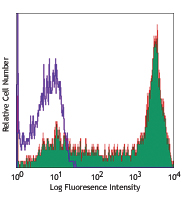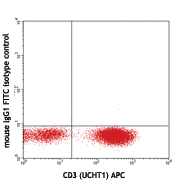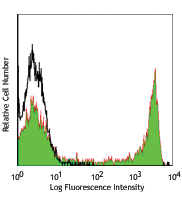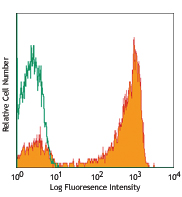- Regulatory Status
- RUO
- Other Names
- Neutralizing antibodies against Spike S1 protein and Spike RBD
- Ave. Rating
- Submit a Review
- Product Citations
- publications
Severe Acute Respiratory Syndrome Coronavirus 2 (SARS-CoV-2) is a single stranded RNA virus that belongs in a family of viruses known as coronaviruses. SARS-CoV-2 infection, known as COVID-19, was declared a pandemic in 2020 and among other symptoms leads to respiratory infection, pulmonary failure which can be fatal. SARS-CoV-2 is structurally composed of 4 main proteins (e.g. spike glycoprotein, envelope glycoprotein, membrane glycoprotein and nucleocapsid protein) and several accessory proteins. The coronavirus spike (S) glycoprotein is a class I viral fusion protein on the outer envelope of the virion that plays a critical role in viral infection by recognizing host cell receptors and mediating fusion of the viral and cellular membranes. The S glycoprotein is synthesized as a precursor protein consisting of ~1,300 amino acids (aa) that is then cleaved into an amino (N)-terminal S1 subunit (~700 aa) and a carboxyl (C)-terminal S2 subunit (~600 aa). The S1 subunit contains a receptor-binding domain (RBD) that can specifically bind to angiotensin-converting enzyme 2 (ACE2), the receptor on target cells which triggers an infusion process then the coronavirus entry into host cells happens. The neutralization antibody in circulating system can bind to RBD region and block the binding of RBD and ACE2 which reduces viral entry.
This assay is for research use only.
Kit Contents
- Kit Contents
-
- Setup Beads: PE Beads
- Setup Beads: Raw Beads
- SARS-CoV-2 Neut. Ab Assay Beads B3, 1X
- SARS-CoV-2 Neut. Ab Assay Detection Antibodies, Lyophilized
- SARS-CoV-2 Neut. Ab Assay Standard, Lyophilized
- LEGENDplex™ SA-PE
- LEGENDplex™ Assay Buffer
- LEGENDplex™ Wash Buffer, 20X
- Plate Sealers
- Filter Plate
Product Details
- Verified Reactivity
- Human
- Application
-
1-Plex Assay
Learn more about LEGENDplex™ at biolegend.com/legendplex
Download the LEGENDplex™ software here. - Product Citations
-
- Materials Not Included
-
- Flow Cytometer
- Pipettes and Tips
- Reagent Reservoirs for Multichannel Pipettes
- Polypropylene Microfuge Tubes
- Vortex Mixer
- Sonicator
- Aluminum Foil
- Absorbent Pads or Paper Towels
- Plate Shaker
- Tabletop Centrifuges
- A Vacuum Filtration Unit and a Vacuum Source (if using filter plates)
- Centrifuge with a swinging bucket adaptor for microtiter plates (if using V-bottom plates)
- 1.1 mL polypropylene micro FACS tubes, in 96-tube rack
Related Pages & Pathways
Pages
Related FAQs
- If I don't have a vacuum, how do I remove the liquid from my plate?
-
If you do not have a vacuum, the assay should be run in a V-bottom plate. After centrifugation using a swinging-bucket rotor with a plate adaptor, you can remove the liquid by flicking the plate quickly, dumping the contents into a sink, and patting it dry carefully on a stack of clean paper towels without losing the beads. Alternatively, you can remove the liquid by using a pipette.
- Should I perform the assay with the filter plates or with V-bottom plates?
-
Filter plates or V-bottom plates have been included in some kits for your convenience. A vacuum filtration unit is required to work with the filter plates. However, if you don’t have access to a vacuum manifold or if you prefer, then you can use the V-bottom plates and follow the recommended assay protocols for the type of plates you choose. All plates should be made from low binding polypropylene. Polystyrene ELISA or cell culture plates should not be used.
- After I finish the staining process, how long can I wait before reading my LEGENDplex™ samples?
-
The samples can be kept overnight at 4°C while being protected from exposure to light and be read the next day. There may be a decrease in signal, but overall, the assay results should not be affected. Storing the samples for extended periods of time is not recommended, as it could lead to further reductions in signal.
- What is the shelf life of LEGENDplex™ kits?
-
LEGENDplex™ kits are guaranteed for 6 months from the date of receipt, but may have a shelf life of up to 2 years from the date of manufacture.
- Is special software required for data analysis?
-
Typically flow cytometers generate output files in FCS format (e.g. FCS 2.0, 3.0, or 3.1) and in some cases in list mode file format (LMD). Other software may be available to analyze FCS files. Data generated using LEGENDplex™ kits can be analyzed using the freely available LEGENDplex™ data analysis software. Please check our website for the most updated versions of the software.
Customers Also Purchased












Follow Us